
Edward Winter

The books call 1 f4 f5 2 e4 the Swiss Gambit, but this is a misnomer resulting from a misunderstanding. These opening moves, three consecutive improbabilities, attracted considerable international attention after the theoretician Alexander Wagner (1868-1942) published an article on pages 35-36 of the February 1912 Schweizerische Schachzeitung (see extract above). Entitled ‘A New Gambit. The Swiss Gambit’, it presented the following game from a Swiss correspondence tournament:
Alexander Wagner – Victor Costin
Correspondence
(Notes by Wagner)
1 f4 f5 2 e4 fxe4 3 Nc3 Nf6 4 g4 d5 (‘4…h6 is safer, after which 5 d3 d5! would follow.’) 5 g5 Bg4 6 Be2 Bxe2 7 Qxe2 Ng8 (‘Black has nothing better. If 7…Nfd7 there follows: 8 f5! g6 9 Nxd5 Nc5 10 Nf4!’) 8 Qb5+ Nd7 (‘Best.’) 9 Qxd5 c6 (‘Nor can the second pawn be saved.’) 10 Qxe4 Qc7 11 Nf3 O-O-O 12 Nd4 Nc5 13 Qe3 (‘13 Qf5+ is disadvantageous for White because of 13…e6 14 Nxe6 Re8!’) 13…Qd7 14 Nce2 Qd5 15 Rg1 Rd6 (‘Black’s game is lost because of his lack of scope for development. 15…g6? would be followed by 16 b4! Nd7 17 Ne6 Re8 18 Bb2.’) 16 d3 Ne6 17 Qh3! Kb8 18 c4 (‘Black resigns for the piece cannot be saved.’)
Wagner wrote that in honour of the event he wished to name the new opening (1 f4 f5 2 e4 fxe4 3 Nc3 Nf6 4 g4) the ‘Swiss Gambit’.
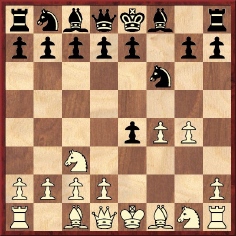
To test the line, so page 168 of the July 1912 American Chess Bulletin reported, Wagner ‘engaged in 15 correspondence games simultaneously against well-known masters and analysts, with the surprising result that only S.R. Wolf managed to draw a game, while the 14 other games were partly won by White and are partly pending, much in favor of White’.
Three games appeared on page 143 of the August 1912 Schweizerische Schachzeitung:
Alexander Wagner – Adam Ritter Zuk von Skarszewski
Correspondence
(Notes from the July-August 1912 Wiener Schachzeitung,
page 196)
1 f4 f5 2 e4 fxe4 3 Nc3 Nf6 4 g4 d5 5 g5 d4 (‘This move proves insufficient.’) 6 gxf6 dxc3 7 fxg7 cxd2+ (‘7…Bxg7 8 dxc3 Qxd1+ 9 Kxd1 e5 or 9…Bg4+ came into consideration.’) 8 Bxd2 Bxg7 9 Qh5+ Kf8 10 O-O-O Qe8 11 Qd5 Bd7 (The Wiener Schachzeitung gave analysis to show that 11…Qc6 would be better.) 12 Bc4 Nc6 13 Ne2 Nd8 14 Bc3 Bxc3 15 Nxc3 Be6 16 Qe5 Resigns.
Alexander Wagner – F. Lipez
Correspondence
1 f4 f5 2 e4 fxe4 3 Nc3 Nf6 4 g4 d5 5 g5 d4 6 gxf6 dxc3 7 fxg7 (On page 222 of the October 1912 American Chess Bulletin A.J. Souweine suggested that 7 Qh5+, followed by 8 Qe5, would lead to ‘an absolutely winning position for White’.) 7…cxd2+ 8 Bxd2 Bxg7 9 Qh5+ Kf8 10 O-O-O Qd4 11 Bc3 Qe3+ 12 Kb1 Bxc3 13 Nh3 Bxh3 14 bxc3 Nd7 15 Bc4 Qb6+ 16 Bb3 Be6 17 Rxd7 Bxb3 18 axb3 h6 19 Rhd1 c5
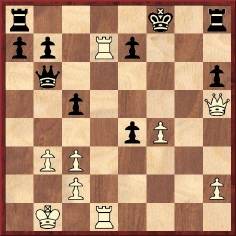
20 Rxe7 Kxe7 21 Qe5+ Qe6 22 Qg7+ Qf7 23 Rd7+ Kxd7 24 Qxf7+ Resigns.
Alexander Wagner – Guyaz
Correspondence
1 f4 f5 2 e4 fxe4 3 Nc3 Nf6 4 g4 d5 5 g5 Bg4 6 Be2 Bxe2 7 Qxe2 d4 8 gxf6 dxc3 9 fxg7 cxd2+ 10 Bxd2 Bxg7 11 Qh5+ Kf8 12 Qf5+ Ke8 13 O-O-O Nc6 14 Bc3 Nd4 15 Qh5+ Kf8 16 Nh3 c5 17 Bxd4 cxd4 18 Ng5 Qe8 19 Ne6+ Kg8 20 Rhg1 Qxh5 21 Rxg7 mate.
Another game was published on pages 197-198 of the July-August 1912 Wiener Schachzeitung:
Alexander Wagner – Caslin
Correspondence
1 f4 f5 2 e4 fxe4 3 Nc3 Nf6 4 g4 e6 5 g5 Nd5 6 Nxe4 Nxf4 7 d4 Ng6 8 Qh5 Qe7 9 Bd3 Qf7 10 Nh3 Ne5 11 Be2 g6
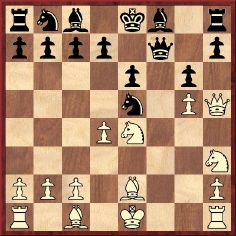
12 dxe5 gxh5 13 Bxh5 Qxh5 14 Nf6+ Kd8 15 Nxh5 Nc6 16 Bd2 Bb4 17 c3 Bf8 18 Bf4 Ne7 19 O-O-O Ng6 20 Rhf1 Be7 21 Ng7 Nf8 22 g6 Resigns.
Adolf Albin discussed the gambit on pages 321-324 of the November 1912 Deutsche Schachzeitung, but gave scant variations, viz. 1 f4 f5 2 e4 fxe4 3 d3 exd3 4 Bxd3 Nf6 5 g4 g6 5 g5 Nh5 and 1 f4 f5 2 e4 fxe4 3 Nc3 Nf6 4 g4 g6 5 g5 Nh5 6 d3 d5 7 Be2 Ng7 8 dxe4 dxe4.
The Schweizerische Schachzeitung reverted to the opening on pages 33-37 of its March 1913 issue, where ‘A.D.’ [Andreas Duhm] wrote an article awash with irony which suggested ‘Lapland Gambit’ as a more appropriate name. He included a game in which Wagner played a future President of FIDE:
Alexander Wagner – Alexander Rueb
Correspondence
1 f4 f5 2 e4 fxe4 3 Nc3 Nf6 4 g4 d5 5 g5 Ng4 6 h3 e5 7 f5 (7 hxg4 exf4 8 g6 f3 – Duhm.) 7…Bxf5 8 hxg4 Bg6 9 d3 Nc6 10 Bg2 exd3 11 cxd3 Nb4 12 Rh3 c6 13 Nce2 Qa5 14 Bd2 Qb5 15 Bxb4 Bxb4+ 16 Kf2 O-O+ 17 Kg3 Bxd3 18 Kh2 e4 19 Nc1 Bf1 20 a4 Bd6+ 21 Kh1 Qxb2 22 Nce2 Bxe2 23 Nxe2 Rf2 24 Re3 Raf8 25 Rb1 Qe5 26 Ng3 Qxg5 27 R1b3 Qh4+ 28 Kg1
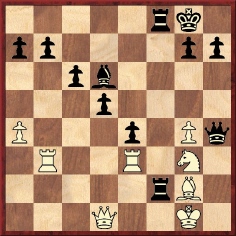
28…R8f3 29 Rxf3 exf3 30 Rxf3 Rxf3 31 White resigns.
Duhm furthermore stated that White could play 7 d3 (though not 7 d4 exf4 8 Bxf4 Nh6 or 8 hxg4 f3) 7…e3 8 hxg4 exf4 (or 8…d4 9 Ne4 fxe4 10 Qf3 Bd6 11 Ne2 O-O 12 Rxh7) 9 Nh3. Another line given by him was 7 d3 Nh6 8 dxe4 d4 9 Nf3, and he also scrutinized the retreat 5…Ng8, as played in the next game:
Alexander Wagner – H. Duhm
Correspondence
1 f4 f5 2 e4 fxe4 3 Nc3 Nf6 4 g4 d5 5 g5 Ng8 6 d3 Bf5 7 dxe4 dxe4 8 Qd5 (Duhm calls this a mistake, recommending instead 8 Qxd8+ Kxd8 9 Bg2.) 8…Qxd5 9 Nxd5 Kd8 10 Be3 Nd7 11 a3 e6 12 Nc3 Ne7 13 Nge2 Nd5 14 Nxd5 exd5 15 Nd4 g6 16 Nxf5 gxf5 17 O-O-O c6 18 Bh3 Bc5 19 Bxc5 Nxc5 20 Bxf5 Ke7 21 Rhf1 Raf8 22 Bg4 Ne6 23 Bxe6 Kxe6 ‘with a very favourable endgame for Black’.
Next, Duhm looked at 1 f4 f5 2 e4 exf4 3 Nc3 Nf6 4 g4 h6 as a means of giving the Black knight a flight square. His article included a game which, with annotations by Black, had appeared on pages 335-336 of the November 1912 Deutsche Schachzeitung:
Alexander Wagner – A. Lenz
Correspondence
1 f4 f5 2 e4 fxe4 3 Nc3 Nf6 4 g4 h6 (Given an exclamation mark by Lenz.) 5 g5 (Duhm said that 5 d3 was not to be recommended because of 5…d5 6 dxe4 Bxg4.) 5…hxg5 6 fxg5 Nh5 (Lenz: ‘…The knight at c3 must take the gambit pawn in order to reach f2 and cope with the threat of …Ng3, on which my entire defensive system was based.’) 7 Nxe4 (According to Duhm, if 7 Bg2 then 7…d5 8 d3 e5 9 Qe2 Nc6 10 dxe4 Nd4 11 Qd3 Bc5, followed by castling, or 7 d3 Ng3 8 Qg4 [8 Bg2 Nxh1 9 Bxe4 d6] 8…Nxh1 9 Qxe4 e6.) 7…d5 8 Nf2 Bf5 (Lenz: ‘From a purely theoretical viewpoint, the opening has been refuted, since Black is developed and has a pawn in the centre and an open rook’s file, while his king is more safely placed than White’s.’) 9 c4 e6 10 Qb3 Bc5 11 Nf3 Ng3 12 hxg3 Bxf2+ 13 Kxf2 Rxh1 14 Nh4 Rxf1+ 15 Kxf1 dxc4 16 Qa4+ Qd7 17 Qxd7+ Nxd7 18 Nxf5 exf5 19 b3 cxb3 20 axb3 Nc5 21 b4 Nb3 22 Rb1 Nxc1 23 Rxc1 Kd7 24 Kf2 Re8 and Black won.
Duhm examined the next game too (which Josef Krejcik had given on pages 194-195 of the July-August 1912 Wiener Schachzeitung):
G. Heim – R. Münz
Vienna, 10 July 1912
1 f4 f5 2 e4 fxe4 3 Nc3 Nf6 4 g4 h6 5 g5 hxg5 6 fxg5 Nh5 7 Be2 g6 8 Nxe4 d5 9 Bxh5 Rxh5 (Duhm considered that 9…gxh5 would give Black a clearly won game.) 10 Ng3 Rxg5 11 d4 Rg4 12 Nf3 Bf5 13 Ne5 Rh4 14 Nxf5 gxf5 15 Ng6 Re4+ 16 Kf1 e6 17 Qh5 Kd7 18 Rg1 Rxd4 19 Qh7+ Be7 20 Nxe7 Rd1+ 21 Kf2 Rxg1 22 Nxf5+ Kc6 23 Nd4+ Kb6
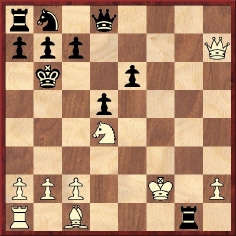
24 Be3 Rxa1 25 Nxe6+ d4 26 Nxd8 dxe3+ 27 Kxe3 Nc6 28 Nxc6 bxc6 29 Qd3 Re8+ 30 Kd2 Rae1 31 Qb3+ Kc5 32 Qc3+ Kd6 33 Qg3+ R1e5 34 h4 Ke6 35 h5 Rd8+ 36 Kc1 Rdd5 37 Qg6+ Ke7 38 c4 Rc5 39 h6 Rxc4+ 40 Kd2 Rh4 41 h7 Reh5 42 Qxc6 Kd8 43 Qa8+ Kd7 44 Qxa7 Rxh7 45 a4 Rh2+ 46 Kc3 R7h3+ 47 Kc4 Rc2+ 48 Kd5 Rxb2 49 a5 Ra2 50 a6

50…Ra4 51 Ke5 Rh5+ 52 Kf6 Rxa6 53 White resigns.
The May-June 1913 Wiener Schachzeitung (pages 130-143) added much further material on the Swiss Gambit, including contributions by Wagner. Among the games given were two against Hauke:
Alexander Wagner – A. Hauke
Correspondence, 1913
(Punctuation by Wagner)
1 f4 f5 2 e4 fxe4 3 Nc3 Nf6 4 g4 h6 (‘Of the possible defences, this is the weakest. Black aims to obtain a completely open rook’s file, but nothing particular is achieved thereby.’ – Wagner.) 5 g5 hxg5 6 fxg5 Nh5? 7 Be2!! Nf4? (‘7…g6 is much better, and after 8 Bxh5 gxh5. The only game my opponent won continued that way, whereas Black lost a game with 7…g6 8 Bxh5 Rxh5.’ – Wagner.) 8 d3 exd3 9 Bxf4 dxe2
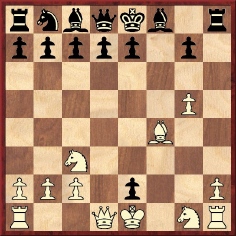
10 Qd3! d6 11 Qg6+ Kd7 12 Ngxe2 Qe8 13 Qe4 Kd8 14 g6! Qc6 15 Nd5 Rh5? 16 c4 Qd7 17 Rf1! Rh8 18 Bg5 Nc6 19 Nd4! Ne5 20 Qh4!! Rxh4 21 Rxf8+ Qe8 22 Rxe8+ Kxe8 23 Bxh4 c5! 24 Nb5 Nf3+ 25 Kf2 Nxh4 26 Ndc7+ Kf8 27 Nxa8 a6 28 Nab6! Bf5 29 Kg3 Nxg6 30 Rf1 axb5 31 Rxf5+ Ke8 32 Rg5 Kf7 33 Rxg6! Kxg6 34 cxb5 Kf7 35 a4! Resigns.
Alexander Wagner – A. Hauke
Correspondence, 1913
(Notes and punctuation by Wagner)
1 f4 f5 2 e4 fxe4 3 Nc3 Nf6 4 g4 c6! (‘This interesting variation, first indicated by Professor Ziolo, reveals new charms in the Swiss Gambit. Nevertheless, I regard 4…e6, which the master S.R. Wolf used against me, as theoretically better, because it has the threefold aim of opening up a path for the bishop at f8, preventing f5 and saving the king by giving it breathing space.’) 5 g5? (‘At that time I was not yet ready with my analysis of this variation. In this one line alone it is necessary to play 5 d3 first, with the continuation 5…d5 6 g5 Bg4 7 Qd2 Nfd7 8 dxe4 e6 9 Qg2 Bh5 10 Qh3 Bf7, with the better game for White. Or 5 d3 exd3 6 g5 dxc2 7 Qxc2 Nd5 8 Bd3 Nxc3? 9 Bg6+ hxg6 10 Qxg6 mate. Black rises and leaves the premises.’) 5…Nd5 6 f5! (‘Best; otherwise the attack is quickly over.’) 6…Qa5 (In a consultation game in the Cracow Club against Professor Ziolo 6…Qc7 was played here. Both moves aim to make room for the king.’) 7 Qh5+ Kd8 8 Bh3 (‘8 Nxe4 would naturally be followed by 8…Ne3, and Black wins.’) 8…d6 9 Nge2 Nxc3 10 dxc3! Nd7 (‘If 10…Bxf5? then 11 g6!’) 11 Qh4! Ne5 12 Qxe4 g6 13 Nd4 Bg7 14 Ne6+ Bxe6 15 fxe6 (‘This pawn looks sickly, but it survives the game, which ends in a draw.’) 15…Rf8 16 Rf1 Rxf1+ 17 Bxf1 Kc7 18 a4 Rf8 (‘The game was agreed drawn at the 52nd move after a protracted ending with opposite-colour bishops.’)
In an article in the May-September 1914 Wiener Schachzeitung, pages 155-159, Krejcik offered the next three games:
E. Hold – R. Münz
Vienna, 28 November 1912
1 f4 f5 2 e4 fxe4 3 Nc3 Nf6 3 g4 g6 4 g5 Nh5 6 d3 d5 7 Be2 Ng7 8 dxe4 dxe4 9 Nxe4 Qxd1+ 10 Bxd1 Bf5 11 Ng3 Nd7 12 Nf3 O-O-O 13 b3 e5 14 fxe5
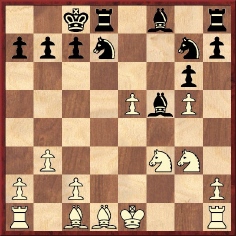
14…Nxe5 15 Nxe5 Re8 16 Bb2 Bd6 17 O-O Bxe5 18 Bxe5 Rxe5 19 c4 Rd8 20 Bf3 Ne6 21 h4 Nd4 22 Rc1 Re3 23 Kg2 Nxf3 22 Rxf3 Rd2+ 25 Rf2 Bh3+ 26 Kg1 Rxg3+ 27 Kh2 Rg2+ 28 Rxg2 Bxg2 29 White resigns.
E. Hold – R. Münz
Vienna, 1912
1 f4 f5 2 e4 fxe4 3 Nc3 Nf6 3 g4 g6 4 g5 Nh5 6 d3 d5 7 Be2 Ng7 8 dxe4 dxe4 9 Qxd8+ Kxd8 10 Nxe4 Bf5 11 Bd3 Nd7 12 Nf3 Bxe4 13 Bxe4 Nc5 14 Bd5 e6 15 Bc4 Bd6 16 b4 Nd7 17 a3 Rf8 18 Nd4 Bxf4 19 Bxf4 Rxf4 20 Nxe6+ Nxe6 21 Bxe6 Re4+ 22 White resigns.
E. Hold – G. Heim
Vienna, 10 October 1912
1 f4 f5 2 e4 fxe4 3 Nc3 Nf6 4 g4 d5 5 g5 Ng4 6 h3 e5 7 hxg4 exf4 8 Nh3 Be7 9 Nxf4 Bxg5 10 d3 Bh4+ 11 Kd2 e3+ 12 Kxe3 d4+ 13 Kd2 dxc3+ 14 bxc3 O-O 15 Qf3 Rxf4 16 Resigns.
Krejcik’s article was followed by a contribution from Georg Marco, who added another Swiss miniature:
N.N. – A. Onderka
Occasion?
1 f4 f5 2 e4 fxe4 3 Nc3 Nf6 4 g4 Nc6 5 g5 Ng8 6 Nxe4 d5 7 Ng3 e5 8 d3 Bd6 9 Qe2 Nge7 10 fxe5 Bxe5 11 Nf3 Bg4 12 Bg2 Qd6 13 Qf2 O-O 14 c3 Nf5 15 Nxf5 Rxf5 16 Rf1 Raf8 17 Qe2 Bxc3+ 18 Resigns.
Marco also reported on a line from Max Köppel: 1 f4 f5 2 e4 fxe4 3 Nc3 Nf6 4 g4 e5, with two variations:
a) 5 fxe5 Bc5 6 exf6 Qxf6 7 Nxe4 Qh4+ 8 Ng3 d5, and
b) 5 g5 Ng4 6 Qxg4 d5 7 Qg3 exf4 8 Qxf4 Bd6.
Finally, he mentioned 4…b6, played by Constantin Mandrila in a correspondence game against Julius Wagner Ritter von Jauregg. After 4 g5 Ng8 6 Nxe4 d5 7 Ng3 Mandrila recommended as best 7…g6.
It should not, however, be imagined that 1 f4 f5 2 e4 was first seen around 1911. As shown in the illustration above, Wagner himself acknowledged in the Schweizerische Schachzeitung that those moves had been dealt with, by F.A. Lange, on pages 182-186 of the June 1859 Deutsche Schachzeitung. The following were the main lines given by Lange:
a) 1 f4 f5 2 e4 fxe4 3 Qh5+ g6 4 Be2 gxh5 5 Bxh5 mate (‘Let us begin with a joke.’).
b) 1 f4 f5 2 e4 fxe4 3 f5 Nf6 4 Be2 h5 (the magazine added an editorial note recommending 4…g6 as stronger) 5 Nh3 d5 6 O-O e6 7 fxe6 Bxe6 8 Ng5 Bg4 9 d3.
c) 1 f4 f5 2 e4 fxe4 3 Bc4 Nf6 4 d3 d5 5 Bb3 exd3.
d) 1 f4 f5 2 e4 fxe4 3 Nc3 Nf6 4 d3 exd3 (4…d5 5 dxe4 dxe4 6 Qe2 Bf5 7 Qb5+ Bd7 8 Qxb7 Bc6 9 Qb3 or 5…Nxe4 6 Nxe4 dxe4 7 Qh5+ g6 8 Qe5) 5 Bxd3 e6 6 Bd2 Bc5 7 g4 O-O (7…Nh5 8 Nf3; 7…Nd5 8 g5 g6 9 Nxd5 exd5 10 Qe2+ Qe7 11 Qxe7+ Bxe7 12 h4 d6 13 h5 Bf5 14 Bxf5 gxf5 15 Bc3 Rf8 16 O-O-O c6 17 g6 and White stands better) 8 g5 Nd5 (or 8…Ne8 9 Qh5 g6 10 Bxg6 hxg6 11 Qxg6+ Kh8 12 Ne4 Qe7 13 Bc3+ Ng7 14 Qh6+ Kg8 15 Nf6+ with advantage) 9 Qh5 g6 10 Bxg6 Qe7 11 O-O-O hxg6 12 Qg6+ Qg7 13 Qxg7+ Kxg7 14 Nxd5.
When the Handbuch subsequently referred to the above line it gave 5…d5 as leading to the better game for Black, and it was this that prompted Wagner to turn to 4 g4 instead of 4 d3. The title of his original article (‘A New Gambit. The Swiss Gambit’) was to be misinterpreted, but at no stage did he name 1 f4 f5 2 e4 after Switzerland or claim to have invented those moves. In an identically entitled article on pages 193-194 of its July 1912 issue, the Deutsche Schachzeitung gave the move 4 g4 in bold type, once again indicating that the mere moves 1 f4 f5 2 e4 were not being called the Swiss Gambit. On the other hand, the BCM (March 1912, page 111) implied the opposite, by omission.
In the same June 1859 issue of the Deutsche Schachzeitung which published Lange’s analysis there appeared (page 198) this score:
Vollrath – E. Fischer
Correspondence, 24 September 1858-25 March 1859
1 f4 f5 2 e4 fxe4 3 d3 exd3 4 Bxd3 Nf6 5 g4 d5 6 g5 Bg4 7 Qd2 Nfd7 8 Qg2 Be6 9 b4 Nc6 10 a3 g6 11 Bb2 Rg8 12 Qe2 Bf7 13 Nf3 Bg7 14 Bxg7 Rxg7 15 Nbd2 e6 16 Kf2 Qe7 17 Nb3 Qd6 18 Qe3 Bg8 19 Bb5 Re7 20 Bxc6 Qxc6 21 c3 b6 22 a4 Qd6 23 Rhe1 c5 24 b5 a5 25 Nbd2 O-O-O 26 Ne5 Rf8 27 Kg3 Nxe5 28 Qxe5 Qd8 29 Nf3 Rf5 30 Qe3 e5 31 fxe5 d4 32 cxd4 Bd5 33 Nh4 cxd4 34 Qc1+ Rc7
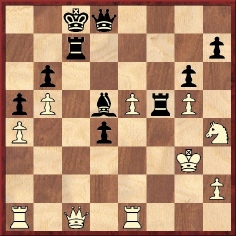
35 Nxf5 Rxc1 36 Raxc1+ Kd7 37 e6+ Bxe6 38 Nxd4 Qxg5+ 39 Kf2 Qf4+ 40 Nf3 Bd5 41 Rc3 Bxf3 42 Rxf3 Qxh2+ 43 Kf1 Qh1+ 44 Kf2 Qh4+ 45 Kf1 Kd6 46 Rfe3 Qc4+ 47 Kf2 h5 48 Re4 Qf7+ 49 Kg3 g5 50 Rd1+ Kc5 51 Re5+ Kb4 52 Re4+ Kc5 53 Re5+ Kb4 54 Re4+ Kc3 55 Rde1 h4+ 56 Kg2 h3+ 57 Kg3 Qh5 58 Kf2 h2 59 R1e3+ Drawn.
There follow some further nineteenth-century games beginning 1 f4 f5 2 e4:
F.A. Lange – W. Schulten
Duisburg, April 1860
1 f4 f5 2 e4 fxe4 3 Nc3 Nf6 4 d3 d5 5 dxe4 dxe4 6 Qe2 Nc6 7 Nxe4 Nxe4 8 Qxe4 g6 9 Bb5 Bd7 10 Be3 Bg7 11 O-O-O Qc8 12 Nf3 a6 13 Bxc6 Bxc6 14 Qc4 Bxf3 15 gxf3 b5 16 Qc6+ Kf7 17 Rd7 Re8 18 Rxc7 Qf5 19 Rd1 Rad8 20 Rcd7 Rc8 21 Qe4 Qxe4 22 fxe4 Rc4 23 e5 Rec8 24 Kb1 Rxc2 25 Ra7 R8c6 26 Rc1 Rxc1+ 27 Bxc1 g5 28 f5 Bxe5 29 Bxg5 Bf6 30 h4 h6 31 Bxf6 Kxf6 32 b4 Kxf5 33 Rxe7 Rc4 and Black won.
(Source: Deutsche Schachzeitung, April 1861, pages 130-131.)
A. Küsel – C.F. Huch
USA (exact occasion?)
1 f4 f5 2 e4 fxe4 3 f5 Nf6 4 Be2 h5 5 Nh3 d5 6 O-O Qd6 7 Nf4 Bxf5 8 Nxh5 Bg6 9 Nxf6+ exf6 10 h3 Qg3 11 Bg4 Bc5+ 12 Kh1 Bd6 13 Kg1 Qh2+ 14 Kf2 f5 15 Be2 and Black gave mate in seven. However, our computer offers 15…e3+ 16 Kxe3 Qe5+ and mate in three more moves.
(Source: Deutsche Schachzeitung, June 1872, page 167.)
Henry Edward Bird – Oscar Gelbfuhs
Vienna, 22 July 1873
1 f4 f5 2 e4 fxe4 3 d3 exd3 4 Bxd3 Nf6 5 Nf3 e6 6 Ng5 g6 7 h4 Bh6 8 h5 Bxg5 9 fxg5 Nd5 10 hxg6 Qe7 11 Rxh7 Rxh7 12 gxh7 Qb4+ 13 Kf1 Qh4 14 Bg6+ Ke7 15 Qh5 Resigns.
(Sources: Deutsche Schachzeitung, November 1873, page 328, and page 17 of the Vienna, 1873 tournament book.)
C.P. Hofstede de Groot – Adolf Anderssen
Amsterdam, 15 July 1875
1 f4 f5 2 e4 fxe4 3 d3 exd3 4 Bxd3 Nf6 5 Nf3 e6 6 Nc3 Be7 7 Ne4 Nc6 8 c3 d6 9 Nfg5 Nxe4 10 Nxe4 g6 11 Qe2 e5 12 O-O Bf5 13 Ng5 Bxd3 14 Qxd3 Bxg5 15 fxg5 Qe7 16 Qh3 Qd7 17 Be3 Qxh3 18 gxh3 and White resigned about ten moves later.
(Source: Deutsche Schachzeitung, September 1884, page 280.) The magazine observed that the game had historical value, to which Hermann von Gottschall added on page 433 of his monograph on Anderssen, ‘it certainly has no other value’.
A lull ensued, and the interest generated by Wagner prior to the Great War also proved transient. The moves 1 f4 f5 2 e4 seldom resurfaced, although our final two games here were played within a month or so of each other:
Julius Pelikán – Alexander Alekhine
Poděbrady, 18 July 1936
1 f4 f5 2 e4 fxe4 3 d3 e3 4 Bxe3 Nf6 5 d4 e6 6 Bd3 Nc6 7 a3 Ne7 8 Nh3 b6 9 O-O Bb7 10 Nd2 g6 11 Bf2 Bg7 12 c3 O-O 13 Qe2 a5 14 a4 Nfd5 15 Bh4 Qe8 16 g4 Nf6 17 Ng5 Ned5 18 Bg3 Qe7 19 Nde4 Nxe4 20 Nxe4 c5 21 dxc5 bxc5 22 h4 e5 23 fxe5 Bxe5 24 Bxe5 Qxe5 25 Nf6+ Qxf6 26 Rxf6 Nxf6 27 g5 Nh5 28 Qe7 Rf7 29 Qxc5 Nf4 30 Bc4 d5 31 Bf1 Re8 32 b4 Re4 33 Qd6 axb4 34 cxb4 d4 35 a5 d3 36 a6 Ba8 37 Rc1 Ne2+ 38 Bxe2 dxe2 39 Qg3 h5 40 gxh6 Kh7 41 b5 Ref4 42 h5 gxh5
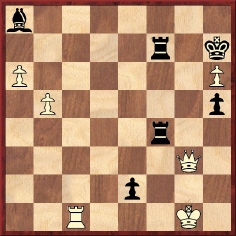
43 Qxf4 Rxf4 44 b6 Bf3 45 b7 Rc4 46 Re1 Bxb7 Drawn.
Karel Hromádka – Kornel Havasi
Munich Olympiad, 21 August 1936
1 f4 f5 2 e4 fxe4 3 Nc3 Nf6 4 g4 g6 5 g5 Nh5 6 d3 exd3 7 f5 Ng7 8 fxg6 hxg6 9 Bxd3 Nf5 10 Bxf5 gxf5 11 h4 e6 12 h5 Qe7 13 h6 Qf7
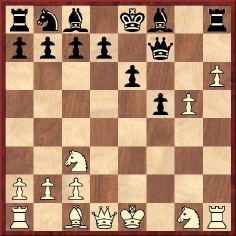
14 Bf4 d6 15 Qe2 Nc6 16 Qg2 Ne7 17 O-O-O Bd7 18 Qxb7 Bc6 19 Qxc7 Bxh1 20 Qxd6 Nc6 21 Nb5 Bxd6 22 Nxd6+ Kf8 23 Nxf7 Kxf7 24 Rd7+ Kg6 25 Rg7+ Kh5 26 h7 e5 27 Bd2 f4 28 g6 Be4 29 Rc7 Kxg6 30 White resigns.
This game was given on pages 22-23 of Kornel Havasi and Dr Geza Nagy by W.A. Földeák, published by The Chess Player in 1996.
Nowadays, the opening is seen mainly, if at all, in correspondence tourneys, and is invariably labelled ‘the Swiss Gambit’. Given that Lange discussed 1 f4 f5 2 e4 half a century before the Swiss appellation was proposed by Wagner (who, in any case, applied it only to the 4 g4 line), it cannot be justified to continue calling 1 f4 f5 2 e4 the Swiss Gambit.
The above article first appeared at the Chess Café in 1998.
On page 7 of the 25 March 1893 edition of the Nottinghamshire Guardian Olimpiu G. Urcan has found a game illustrating ‘A new gambit, played at the Café Union, Munich, in April last, between “Einsiedler in Schwabing” and E. Varain, editor of the Süddeutsche Schach-Zeitung’:

1 f4 f5 2 e4 fxe4 3 d3 Nf6 4 Nc3 d5 5 dxe4 d4 6 Bc4 c5 7 e5 Nc6 8 Qe2 Ng4 9 Ne4 Qb6 10 Nf3 Ne3 11 Bxe3 Qxb2 12 O-O dxe3 13 Qxe3 Nd4 14 Nxc5 Nxf3+ 15 Qxf3 Qxc2 16 Rfc1 Qf5 17 Nxb7 Rb8 18 Rab1 Bxb7
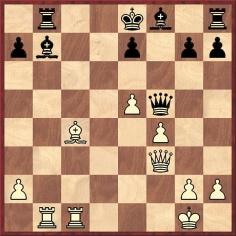
19 e6 Qc5+ 20 Kh1 Qc7 21 Bb5+ Kd8 22 Rxc7 Bxf3 23 Rd7+ Ke8 24 Rd5+ Rxb5 25 Rbxb5 Bxd5 and White mates.
(7626)
To the Chess Notes main page.
To the Archives for other feature articles.
Copyright: Edward Winter. All rights reserved.